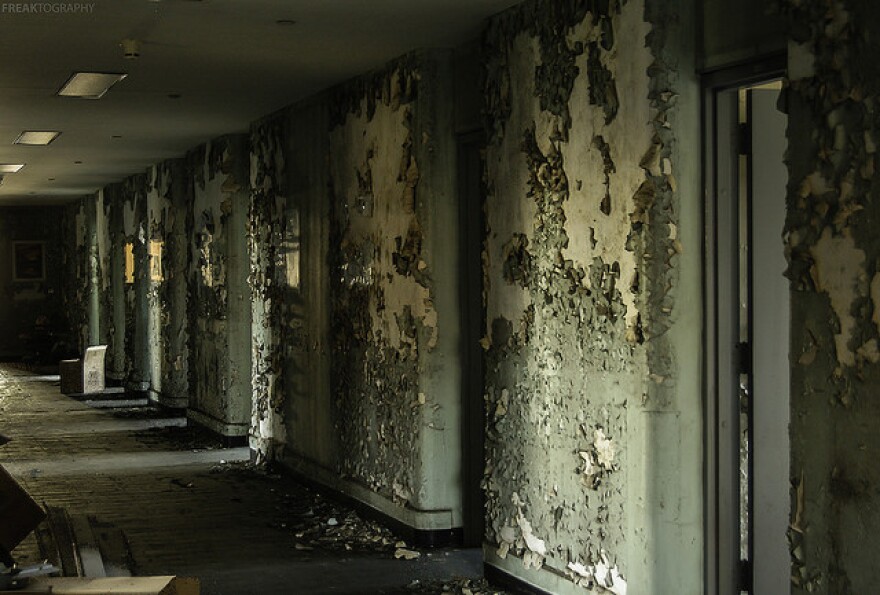The state of New Hampshire has been officially providing care for its mentally ill citizens for over 170 years. In that time, there have been dramatic changes in the living conditions for patients – and the state’s approach to treatment.
In 1989, New Hampshire Hospital built a state of the art facility that sought to provide individualized care for patients with the most severe symptoms.
To mark that occasion, NHPR produced a two-part report on the history and future of New Hampshire Hospital. In part one today, you’ll hear reporter Kathy McLaughlin chronicle the living conditions in the old hospital buildings. Barred windows, dim lighting, and crowded sleeping wards fostered a rather gloomy environment.
From the archives this week, the inside history of New Hampshire Hospital, from reporter Kathy McLaughlin.
The Peaslee-One annex off the main building had one of the oldest back wards on the hospital grounds. Built in 1844, it housed the most hyperactive and potentially dangerous of the mentally ill. There was a long, narrow corridor with a row of small rooms on either side. On one end, a large bathroom. On the other, what resembled a jail cell door. Only a few rays of sunlight streamed through the bar windows onto a cement floor covered with a thick layer of paint chips.
Everywhere, the walls were peeling, revealing layer after layer of institutional shades of gray, green, blue and yellow paint.
There was little hope of recovering from mental illness. Hospital officials believed the environment - the dimly lit back wards, the barred windows, the cold cement floors and walls - did much to reinforce that idea.
“I had been a social worker for maybe six or seven months when a person who was here for evaluation hung himself,” said Dave Worcester, a former longtime employee of the hospital. “What we finally realized after we thought the whole thing through and looked at it was that the poor fellow had become confused about what day it was. His girlfriend came to visit him on Tuesday, Thursday and Saturday. And this happened to be a Wednesday, but for some reason he thought it was a Tuesday or a Thursday. And when she didn’t come to visit him he was so despondent that he reacted. There was no way that anyone could have predicted that, but I think that also tells you something about what it would be like to be in an institution where one day is the same as the next day.”
Worcester said most patients spent their days in a large room called the “day room”, and their nights in another large room lined with beds so closely spaced that the occupants had just enough room to squeeze in between the rows. There was little privacy in those days, he said, and that was still apparent. In the Walker building, for example, there was a bathroom once used by an entire ward – 50 people or more. Worcester said the doors were always kept ajar and the windows curtainless for the patients’ safety. And all of the windows, he said, were barred.
“I think they were a reaction to what people expected from an asylum,” he said. “They wanted to know that the folks who came here were going to be not only protected from themselves – that’s what the asylum was all about – but also that society would be protected from them. The bars on the window gave you the sense that this was a very secure place, and the people who came here really needed to be here. And so it was okay for them to be here.”
Nurses In Charge
The wards in the early days were largely controlled by the nurse and her attendants, who would sit behind screened offices watching over the patients in the day rooms. The former director of nursing at N.H. Hospital worked there for almost 30 years. She said that at one time, the nurse was considered the caretaker, the parent – picking out patients’ clothes, telling them when to eat and when to bathe.
“Many years ago we had patients who would call the nurse ‘Mama’,” she said. “And as a matter of fact, the attendants, which would be the employees, also perceived that person as a parent. And in those days, you worked long shifts. So that if you wanted a weekend day off you had to please the parent. We used to have our Nurse Cratchets, you know. Because of course the nurturing thing and the parent thing is a powerful position. Keys are a power symbol. So yeah, we had Cratchets.”

Perhaps it was the nurturing that patients received that caused many of them to remain after de-institutionalization. On the hospital grounds in the Thayer building was the nursing home facility that housed a number of elderly patients. Many of them lived at the hospital much of their lives, and had nowhere else to go.
When some of them were admitted over 50 years before, there was little hope of recovering from mental illness. Hospital officials believed the environment – the dimly lit back wards, the barred windows, the cold cement floors and walls – did much to reinforce that idea.
With the 1989 opening of a modern, state-of-the-art facility on the grounds in Concord, hospital officials believed they had provided a more hopeful environment for their patients.
Don’t miss part two next week. We’ll hear Martin Murray interview the superintendent of the then-brand-new hospital facility to find out how treatment plans for the mentally ill had evolved.
We’ll also talk with NHPR Health & Science reporter Jack Rodolico about the state of mental health in New Hampshire today.








